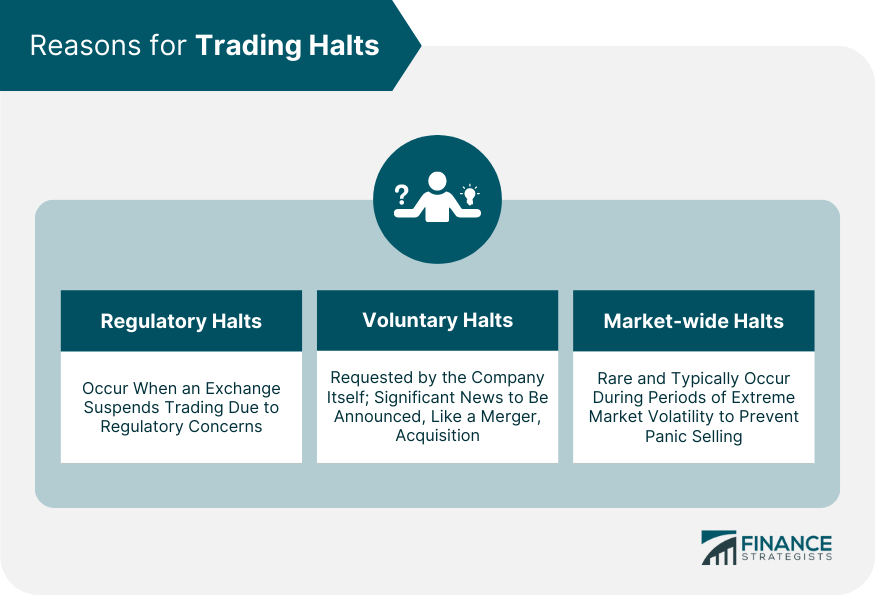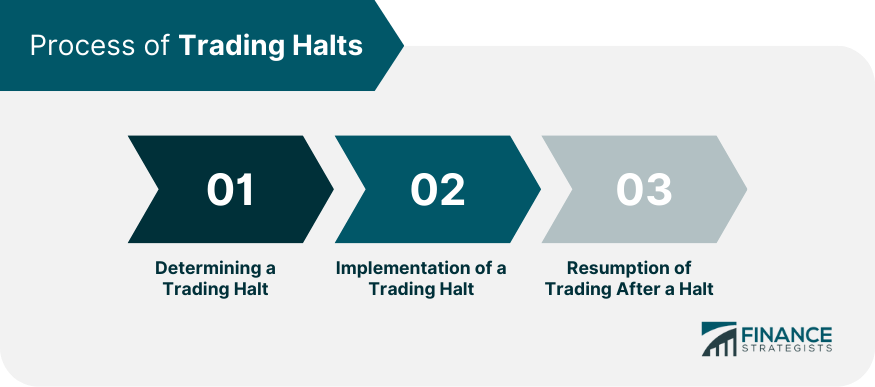A trading halt is a temporary suspension of trading for a particular security or securities at one specific exchange or across multiple exchanges. Trading halts are typically enacted in anticipation of a news announcement, to correct an order imbalance, or in response to a technical glitch in the trading system. They can also be triggered by severe market volatility, thereby acting as circuit breakers to prevent potential market crashes. Such halts ensure that all market participants have the same information, allowing for fair trading. Depending on the reason behind the halt, this pause can last from a few minutes to several days. Trading halts are a key aspect of maintaining an orderly, efficient, and fair stock market. Regulatory halts occur when an exchange suspends trading in security due to a regulatory concern. One example is when there is a significant violation of rules and regulations. The Securities and Exchange Commission (SEC) or other regulatory bodies may halt trading to protect investors from fraudulent or misleading practices. Another reason for a regulatory halt could be an investigation into a company's corporate actions. If there is suspicion around insider trading or a major corporate announcement, a halt can be imposed to ensure the market is fair and informed. Voluntary halts are requested by the company itself. These often occur when a company has significant news to announce, such as a merger or acquisition, a product launch, or a change in top leadership. The halt provides time for the market to digest the news and for the company to ensure that all investors receive the information simultaneously, preventing any unfair trading advantages. Market-wide halts are rare and typically happen during periods of extreme market volatility. For instance, during the global financial crisis of 2008 or the COVID-19 pandemic, such halts were instituted to prevent panic selling. They serve as a circuit breaker to provide investors time to understand the situation better and make more informed decisions. The exchanges or regulatory bodies make the decision to halt trading. They use various indicators to determine when a halt may be necessary. For instance, they monitor price volatility, investigate unusual trading activity, and check for pending news announcements from the company. Once the need for a halt is established, the exchange issues a notification announcing the halt and its reasons. The duration of a halt can vary from a few minutes to several days, depending on the situation. After the halt period, trading resumes. The exchange ensures that all market participants receive information about the halt and its reasons before trading restarts. This process safeguards the principles of a fair and transparent market. The immediate effect of a trading halt is a pause in the trading of the specific security. The halt may cause a significant change in the supply and demand dynamics of the security, leading to a gap in the trading price when trading resumes. While the direct impact is on the specific security, trading halts can also influence the broader market sentiment, particularly if the halt involves a major company or is due to significant economic news. For investors, trading halts can be a source of uncertainty, leading to potential financial risk or opportunity. For instance, news-pending halts might make investors speculate about the announcement, impacting their investment decisions. The NYSE has a set of regulations in place to determine when a halt is necessary. These regulations are designed to protect investors and ensure the smooth functioning of the markets. The NASDAQ follows a similar set of rules as the NYSE for halting trading. However, the specifics can vary, especially in terms of the technology used to detect unusual trading activity. While trading halts are designed to ensure fair and orderly markets, they can be controversial. Critics argue that they can be manipulated by large market players to their advantage, leading to an uneven playing field for smaller investors. Frequent or extended trading halts can undermine investor confidence, leading to uncertainty and increased market volatility. It can make investors wary of investing in certain stocks or sectors, impacting the overall market liquidity. Trading halts are temporary suspensions of trading for specific securities or across multiple exchanges. They are implemented for various reasons, including regulatory concerns, voluntary requests by companies, or during periods of extreme market volatility. Trading halts ensure fair and transparent markets, allowing for the dissemination of important news and preventing panic selling. The process involves determining the need for a halt, issuing notifications, and resuming trading after the halt period. Trading halts have an impact on the specific security, broader market sentiment, and investors' decisions. Different exchanges, such as the NYSE and NASDAQ, have regulations in place to govern trading halts. However, controversies and criticisms exist, such as perceived market manipulation and potential effects on investor confidence. Overall, trading halts play a vital role in maintaining order and integrity in the stock market.What Are Trading Halts?
Reasons for Trading Halts
Regulatory Halts
Voluntary Halts
Market-Wide Halts

Process of Trading Halts
Determining a Trading Halt
Implementation of a Trading Halt
Resumption of Trading After a Halt

Impact of Trading Halts
Specific Security
Broader Market
Investors
Trading Halts Across Different Exchanges
New York Stock Exchange (NYSE)
NASDAQ
Controversies and Criticisms Around Trading Halts
Perceived Market Manipulation
Effect on Investor Confidence
Conclusion
Trading Halts FAQs
A trading halt is a temporary pause in the trading of a particular security or securities, either at one specific exchange or across multiple exchanges. It's typically enacted due to pending news announcements, to rectify an order imbalance, in response to a technical issue, or during severe market volatility.
Trading halts can occur for regulatory reasons, such as violations of rules or ongoing investigations into a company's actions. They can also be voluntary, requested by the company if there's significant news pending. Lastly, they can be market-wide, triggered during periods of extreme volatility to prevent panic selling.
Trading halts can create a sense of uncertainty for investors, leading to potential financial risks or opportunities. The halt may lead to significant changes in the supply and demand dynamics of the security, which can impact the trading price when trading resumes.
Yes, trading halts can sometimes be controversial. Critics argue that they can be manipulated by large market players, potentially leading to an uneven playing field for smaller investors. Frequent or prolonged trading halts can also undermine investor confidence.
As market dynamics and trading technologies continue to evolve, so too will the regulations and mechanisms around trading halts. There may be changes in how, when, and why halts are implemented, and the rise of algorithmic and high-frequency trading could lead to more sophisticated halt triggers.
True Tamplin is a published author, public speaker, CEO of UpDigital, and founder of Finance Strategists.
True is a Certified Educator in Personal Finance (CEPF®), author of The Handy Financial Ratios Guide, a member of the Society for Advancing Business Editing and Writing, contributes to his financial education site, Finance Strategists, and has spoken to various financial communities such as the CFA Institute, as well as university students like his Alma mater, Biola University, where he received a bachelor of science in business and data analytics.
To learn more about True, visit his personal website or view his author profiles on Amazon, Nasdaq and Forbes.











